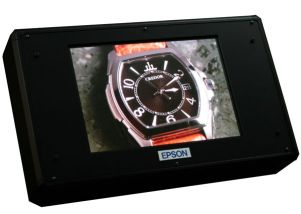Seiko Epson new inkjet technology to enable large size HD OLED TVs
Seiko Epson today announced that it has developed a new inkjet technology that enables uniform deposition of OLED materials in large size displays. They believe that this is a major step towards 37" (or larger) HD OLED TVs.
 Espon 14-inch Inkjet processed OLED
Espon 14-inch Inkjet processed OLED
Seiko Epson claim this is the first technology that can reliably form uniform organic materials on large substrates. The most widely used tech today, Vaccum Thermal Evaporation (VTE) is not able to do it because of several technical issues.
Epson has recently developed the long-awaited solution in the form of
an OLED display fabrication process that leverages the company's
proprietary Micro Piezo inkjet technology to achieve markedly greater
accuracy in organic material deposition than the conventional
technology. The process has been used in trial production to fabricate
a highly uniform prototype panel. Extremely uniform layers (volume
error ejection of multi-size droplets of ink material on a substrate so that
only the required volume of material is deposited.
Epson will give more details at SID, together with a 14" prototype display (shown above), that has a HD resolution.







